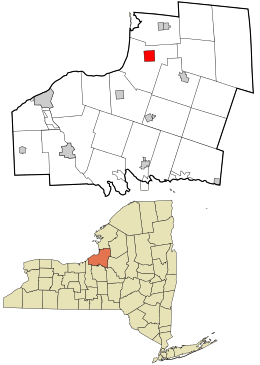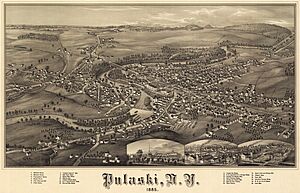Pulaski, New York facts for kids
Quick facts for kids
Pulaski, New York
|
|
|---|---|
|
Village
|
|

Location in Oswego County and the state of New York.
|
|
| Country | United States |
| State | New York |
| County | Oswego |
| Area | |
| • Total | 3.64 sq mi (9.42 km2) |
| • Land | 3.54 sq mi (9.16 km2) |
| • Water | 0.10 sq mi (0.27 km2) |
| Elevation | 371 ft (113 m) |
| Population
(2020)
|
|
| • Total | 2,186 |
| • Density | 618.21/sq mi (238.71/km2) |
| Time zone | UTC-5 (Eastern (EST)) |
| • Summer (DST) | UTC-4 (EDT) |
| ZIP code |
13142
|
| Area code(s) | 315 |
| FIPS code | 36-59960 |
| GNIS feature ID | 0961947 |
Pulaski is a small village in Oswego County, New York, United States. In 2020, about 2,186 people lived there. The village is part of the town of Richland. It is located between the eastern shore of Lake Ontario and the Tug Hill area.
Pulaski is found along U.S. Route 11 and close to Interstate 81. The area is known for heavy lake-effect snow. Winters can be very snowy, often from mid-November to mid-April. This means lots of snow and tough travel conditions.
The village is named after General Casimir Pulaski. However, local people usually say his name with a long "i" sound. The old part of the village was added to the National Register of Historic Places in 1983. It is called the Pulaski Village Historic District.
Contents
Discovering Pulaski's Past
Pulaski became an official village on April 26, 1832. Before that, it had other names like "Fishville" or "Salmon River." Sometimes, the name "Pulaski" was even spelled "Polaski" in old documents.
People are not entirely sure how Pulaski got its name. One idea is that a lawyer named Thomas C. Baker suggested the name in 1829. Another story says that heroes from the Revolutionary War put names in a hat. They then picked the name of Casimir Pulaski. Local historians are still looking into how the name was chosen.
The first court in Oswego County was held in Oswego in 1816. But the first jury was chosen in Pulaski in 1817. A courthouse was built in Pulaski just three years later.
The Selkirk Lighthouse
A few miles west of Pulaski, near the mouth of the Salmon River, stands a lighthouse. In the 1830s, engineers thought the river mouth was deep enough for many ships. So, the Selkirk Lighthouse opened in August 1838. It first used whale oil for its lamp.
The harbor was not used much after 1858. In 1989, a modern navigation light was put in place. The lighthouse was added to the National Register of Historic Places in March 1979.
Pulaski's Schools
In 1853, people in the village wanted better education for their children. They combined parts of three school districts into one. This new district was called the "Pulaski school district," and the school was named "Pulaski Academy."
Today, the Pulaski Academy and Central Schools use two buildings. The Lura Sharp Elementary School was built in 1939. The Pulaski Middle-Senior High School was built in 1969. Other smaller elementary schools in nearby areas closed in the late 1960s or early 1970s.
The Great Fire of 1881
On October 6, 1881, a big fire started in a bakery. In just over three hours, most of Pulaski's business area was destroyed. The buildings were made of wood, and the fire department could not stop the flames.
Factories and Industry
From the 1840s until today, many factories have been in Pulaski. The Salmon River was very important for their growth. Over 120 factories have come and gone. These included wood mills and iron works. Today, only a few industrial companies remain, such as Fulton Companies and Healthway.
The Pulaski Village Historic District and Selkirk Lighthouse are important historic places. They are both listed on the National Register of Historic Places.
Population of Pulaski
| Historical population | |||
|---|---|---|---|
| Census | Pop. | %± | |
| 1880 | 1,501 | — | |
| 1890 | 1,517 | 1.1% | |
| 1900 | 1,493 | −1.6% | |
| 1910 | 1,788 | 19.8% | |
| 1920 | 1,895 | 6.0% | |
| 1930 | 2,046 | 8.0% | |
| 1940 | 1,895 | −7.4% | |
| 1950 | 2,033 | 7.3% | |
| 1960 | 2,246 | 10.5% | |
| 1970 | 2,480 | 10.4% | |
| 1980 | 2,415 | −2.6% | |
| 1990 | 2,525 | 4.6% | |
| 2000 | 2,398 | −5.0% | |
| 2010 | 2,365 | −1.4% | |
| 2020 | 2,186 | −7.6% | |
| U.S. Decennial Census | |||
In 2000, there were 2,398 people living in Pulaski. There were 1,034 households, and 585 were families. About 29.5% of households had children under 18. Around 40.1% were married couples.
The population was spread out by age. About 25.3% were under 18. Around 18.1% were 65 or older. The average age was 38 years.
Getting Around Pulaski
Interstate 81 is nearby. This highway helps people travel to cities like Syracuse and Watertown. This makes Pulaski a good spot for people visiting Lake Ontario and the Tug Hill region.
Pulaski also has bus service from Trailways Bus Lines. There are also three local public transit lines.
Pulaski's Economy and Fun
Pulaski's economy relies a lot on fishing tourism. The village is on the Salmon River. This river is famous for salmon that return each fall. The area is a big draw for sportfishing. Lake Ontario is also just three miles west.
The fishing season ends with the Salmon River Festival each fall. This event brings many visitors. In 1987, the mayor said that salmon season brought $3 to $5 million to the village. This money helps local businesses a lot. Fishermen can find reports to know the best time to fish.
Pulaski is also part of a large snowmobile trail system. These trails connect to others across central and northern New York. This brings many winter tourists. The area gets a lot of snow, especially in the Tug Hill region. This helps make winter tourism popular.
Summer tourism is also strong. People come for Lake Ontario and its activities. These include white water rafting, parks, and resorts. Thousands of people camp here every year.
Pulaski's Weather
| Climate data for Pulaski, New York, 1991–2020 normals, 1948-2020 extremes: 399ft (122m) | |||||||||||||
|---|---|---|---|---|---|---|---|---|---|---|---|---|---|
| Month | Jan | Feb | Mar | Apr | May | Jun | Jul | Aug | Sep | Oct | Nov | Dec | Year |
| Record high °F (°C) | 64 (18) |
63 (17) |
79 (26) |
88 (31) |
90 (32) |
92 (33) |
97 (36) |
96 (36) |
93 (34) |
86 (30) |
76 (24) |
66 (19) |
97 (36) |
| Mean daily maximum °F (°C) | 28.7 (−1.8) |
30.5 (−0.8) |
38.5 (3.6) |
51.4 (10.8) |
64.6 (18.1) |
73.1 (22.8) |
78.5 (25.8) |
77.2 (25.1) |
70.7 (21.5) |
57.9 (14.4) |
45.7 (7.6) |
34.3 (1.3) |
54.3 (12.4) |
| Daily mean °F (°C) | 19.9 (−6.7) |
21.9 (−5.6) |
29.0 (−1.7) |
41.5 (5.3) |
53.5 (11.9) |
62.8 (17.1) |
67.9 (19.9) |
66.7 (19.3) |
59.5 (15.3) |
48.8 (9.3) |
37.7 (3.2) |
26.7 (−2.9) |
44.7 (7.0) |
| Mean daily minimum °F (°C) | 11.0 (−11.7) |
13.3 (−10.4) |
19.5 (−6.9) |
31.5 (−0.3) |
42.3 (5.7) |
52.4 (11.3) |
57.2 (14.0) |
56.2 (13.4) |
48.2 (9.0) |
39.6 (4.2) |
29.6 (−1.3) |
19.0 (−7.2) |
35.0 (1.7) |
| Record low °F (°C) | −29 (−34) |
−37 (−38) |
−12 (−24) |
3 (−16) |
23 (−5) |
30 (−1) |
40 (4) |
35 (2) |
22 (−6) |
20 (−7) |
−5 (−21) |
−24 (−31) |
−37 (−38) |
| Average precipitation inches (mm) | 4.15 (105) |
3.31 (84) |
3.01 (76) |
3.90 (99) |
3.93 (100) |
3.83 (97) |
3.67 (93) |
4.52 (115) |
4.00 (102) |
5.14 (131) |
4.14 (105) |
4.44 (113) |
48.04 (1,220) |
| Average snowfall inches (cm) | 53.4 (136) |
43.0 (109) |
13.3 (34) |
2.0 (5.1) |
0.2 (0.51) |
0.0 (0.0) |
0.0 (0.0) |
0.0 (0.0) |
0.0 (0.0) |
0.9 (2.3) |
12.6 (32) |
43.5 (110) |
168.9 (428.91) |
| Source 1: NOAA | |||||||||||||
| Source 2: XMACIS2 (records, monthly max/mins & Laconia 3.6 SSE 2009-2020 snowfall) | |||||||||||||
See also
 In Spanish: Pulaski (Nueva York) para niños
In Spanish: Pulaski (Nueva York) para niños



